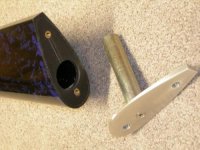The loose shot has a recoil dampening effect over and above the simple effect of it's weight.
It's the same effect you see when you use a "dead blow" hammer.
Dead blow hammers do not bounce because the effect of the blow is stretched out in time. - It keeps pushing down long enough to counteract the tendency to bounce, so all of the power is transferred to the object being struck, instead of part of it being bled off in order to bounce the hammer.
Due to the lead shot being loose in its cavity within the stock, the shots effect upon recoil is spread out over a number of milliseconds, thus affecting the sensation of recoil so that it is less of a sudden, sharp blow and more of a push.
I load the handle of my short, light pool cue with loose shot, with good results by the way. It has power beyond its weight and size because of it.
Some anti-recoil devices utilize mercury within an elongated tube, and these operate by the same principle.


